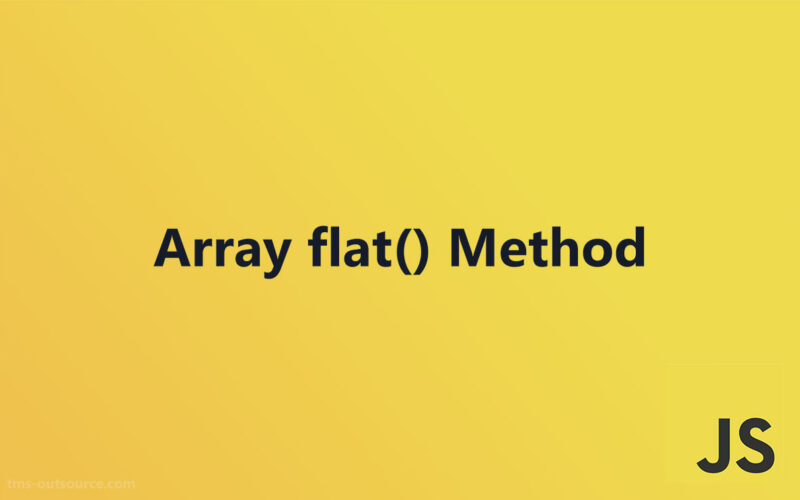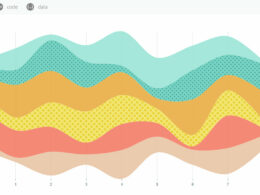Flattening Nested Arrays with JavaScript Array flat() Method

The JavaScript Array flat() Method is a powerful tool for developers, designed to simplify the process of flattening nested arrays.
Whether working on front-end programming tasks or managing complex data structures, understanding how to effectively use this method can greatly enhance code efficiency and readability.
In this article, we’ll explore its syntax, functionality, and practical applications to empower your coding practices.
Technical Overview
Syntax of flat()
Basic syntax structure

The syntax of the JavaScript Array flat() Method is straightforward yet versatile, catering to the needs of developers handling nested arrays. The basic form of this method is written as follows:
let newArray = originalArray.flat([depth]);
In this structure, originalArray represents the nested array that you wish to flatten, and newArray is the resultant array after the flat() method is applied. The method is a part of the Array.prototype, ensuring it’s available on all array instances.
Parameters detailed
- depth: This optional parameter is a number that determines the depth of array levels that
flat()should flatten. If this parameter is omitted, it defaults to 1, meaning that only the first level of nested arrays will be flattened. This parameter allows flexibility, making it a powerful tool for developers dealing with complex array structures.
Return Values
What flat() returns
The JavaScript Array flat() Method returns a new array with all sub-array elements concatenated into it recursively up to the specified depth.
The beauty of this method lies in its return value as it ensures that the original array remains unmodified, supporting immutable data patterns which are common in modern JavaScript development.
Default behavior without parameters
When no parameter is specified, flat() assumes a default depth of 1.
This behavior is crucial for day-to-day coding practices where developers often encounter arrays containing just one level of nested arrays or none at all.
By providing this default behavior, the function facilitates ease of use and enhances code readability, allowing for cleaner and more concise implementations in scenarios involving array manipulation.
In these interactions, the method becomes not just a function but a pivotal element of efficient JavaScript coding, significantly influencing programming approaches and functionalities in web development and software engineering.
Detailed Description and Functionality
How flat() Works
Process of flattening arrays
The essence of the JavaScript Array flat() Method lies in its ability to tackle nested arrays effectively, transforming them into a single-level array.
Imagine dealing with data structures originating from various sources, often nested to various depths. The flat() method comes in handy by iterating through each level of the array and pulling out elements up to the specified depth, simplifying data manipulation tasks immensely.
Treatment of sparse arrays and empty slots
An important aspect of the flat() method is how it handles sparse arrays and empty slots.
When flattening, the method automatically removes empty slots in the arrays, which means no undefined values are left in the resultant array.
This behavior is particularly useful when processing data that may contain gaps or incomplete information, ensuring the outputs are clean and more predictable.
Depth Parameter
Importance and use of the depth parameter
The depth parameter in the flat() method specifies how many levels deep the flattening process should go.
This parameter is crucial for developers dealing with highly nested arrays, allowing precise control over the flattening.
By adjusting the depth parameter, one can ensure that the structure of the array is maintained as needed for specific programming requirements, making the method versatile across different scenarios in web development and software development.
Default depth behavior
By default, if no depth parameter is specified, the flat() method flattens the array to one level deep.
This default setting is logical for ordinary use cases where arrays are minimally nested. However, for deeper nesting, specifying higher values for the depth parameter enables the handling of complex data structures with ease, without additional coding to manually handle each level of nesting.
Practical Examples
Basic Usage
Simple one-level flattening
To demonstrate a basic application of the JavaScript Array flat() Method, consider an array containing a mix of integers and nested arrays, such as [1, 2, [3, 4], 5]. By applying flat() without specifying a depth, the default action flattens one level deep:
const mixedArray = [1, 2, [3, 4], 5];
const flattenedArray = mixedArray.flat();
// Result: [1, 2, 3, 4, 5]
This simple example highlights how flat() seamlessly handles minimal nesting, making it invaluable for everyday coding tasks that involve array manipulations.
Multi-level array examples
For scenarios where arrays are nested multiple levels deep, such as [1, [2, [3, [4]]]], the usage of the depth parameter becomes crucial. Here’s how you can flatten this array up to two levels deep:
const deeplyNestedArray = [1, [2, [3, [4]]]];
const twoLevelFlattenedArray = deeplyNestedArray.flat(2);
// Result: [1, 2, 3, [4]]
This example shows that by adjusting the depth parameter, flat() is flexible enough to handle more complex nested structures, essential for frontend development and server-side JavaScript alike.
Advanced Examples
Using flat() with infinity depth
For the deepest possible flattening, flat() can be used with the depth parameter set to infinity. This approach is perfect when the depth of the array nesting isn’t known beforehand or is highly variable:
const veryDeeplyNestedArray = [1, [2, [3, [4, [5]]]]];
const fullyFlattenedArray = veryDeeplyNestedArray.flat(Infinity);
// Result: [1, 2, 3, 4, 5]
This usage underscores the flat() method’s capability to adapt to dynamic data structures, making it a powerful tool for handling arrays derived from complex data sources like APIs or databases.
Practical applications in data manipulation
The ability to flatten arrays to a specified depth has practical implications in data processing, particularly in tasks involving the extraction and transformation of data from nested structures.
For developers working with data fetched from external sources, which often arrive in multi-level nested arrays, having flat() at their disposal means they can preprocess this data more efficiently and prepare it for display or further analysis.
Whether it’s streamlining client-side data handling in web apps or prepping data for computational tasks in Node.js, the JavaScript Array flat() Method proves to be an essential function in a JavaScript developer’s toolkit, enhancing code efficiency and clarity.
Technical Specifications
Underlying Algorithm
Algorithmic complexity of flat()
The algorithmic complexity of the JavaScript Array flat() Method is primarily O(n), where n is the total number of elements in the array, including nested array elements.
This means that the method iterates over each element of the array once for each level of depth specified.
The efficiency of flat() becomes a focal point when dealing with large and deeply nested arrays, where the complexity can significantly impact runtime.
Performance considerations
When applying flat(), it’s vital to consider that performance may vary based on the depth of the array and the total number of elements.
Larger and more complex data structures might lead to higher processing times. Optimizing the use of flat() involves understanding the data structure, appropriately setting the depth parameter, and testing performance in different browsers and environments to ensure smooth functionality across different platforms.
Compatibility and Support
Browser and environment support
As a relatively new addition to the JavaScript language, introduced in ECMAScript 2019, the JavaScript Array flat() Method enjoys broad support across most modern browsers, including Google Chrome, Firefox, and Safari. However, developers should be wary of its use in older browsers, which may not support this method naturally.
Polyfills for unsupported environments
For environments where flat() is not natively supported, polyfills serve as a practical solution.
A polyfill is a piece of code used to provide modern functionality on older browsers that do not natively support it.
Implementing a polyfill for flat() allows developers to utilize this method in applications that must be compatible with older browsers, ensuring a wider audience can interact with their digital products without encountering functionality issues.
Additional Utilities and Methods
Related Array Methods
Comparison with flatMap()
While discussing array manipulation in JavaScript, it’s crucial to differentiate between the JavaScript Array flat() Method and flatMap().
Essentially, flatMap() is an extension that combines the functionalities of flat() and map() into one method.
This means you can map each element using a mapping function and then flatten the result into a new array. It’s particularly efficient for chaining operations, reducing the need to write separate calls for map() followed by flat().
For instance, if you have an array of numbers and you want to double each number then flatten the output, flatMap() can handle this in one pass:
const nestedNumbers = [[1, 2], [3, 4]];
const doubledFlatNumbers = nestedNumbers.flatMap(subArray => subArray.map(number => number * 2));
// Result: [2, 4, 6, 8]
This method is not only concise but also improves script performance by minimizing the need to traverse arrays multiple times.
Synergy with other array methods like map() and filter()
The strength of the JavaScript Array flat() Method grows when used in conjunction with other array methods like map() and filter().
These methods empower developers to create more readable and efficient code by chaining processes logically.
Take a scenario where you need to process information from a structured data format involving nested arrays, perhaps filtering out specific items before flattening the structure. Here’s how you could achieve it:
const rawData = [[1, 2, 3], [4, 5, 6], [7, 8, 9]];
const processedData = rawData.map(subArray => subArray.filter(number => number > 4)).flat();
// Result: [5, 6, 7, 8, 9]
This synergy allows for processing complex data structures in a streamlined and effective manner, showcasing how powerful these combined methods can be in front-end programming and software development.
FAQ On JavaScript Array Flat() Method
What is the JavaScript Array flat() Method?
The JavaScript Array flat() Method simplifies arrays by merging nested arrays into a single array up to a specified depth, smoothing out inconsistencies and making the data easier to handle in web development and software engineering tasks.
How does the flat() method handle multiple levels of nested arrays?
Using the optional depth parameter, you can control the levels of nested arrays the flat() method should consolidate. Without specifying this parameter, it defaults to flattening just one level deep.
What types of data can the flat() method process?
The flat() method is versatile, working effectively with any array elements, including numbers, strings, and objects. It is particularly valuable for developers when dealing with complex data structures in JavaScript programming.
Can flat() remove empty slots in arrays?
Yes, a handy feature of the flat() method is its ability to clear out empty slots in arrays. This function ensures cleaner and more predictable outcomes when managing data arrays, enhancing the overall functionality.
Is the flat() method available in all browsers?
While most modern browsers support the flat() method, older versions might not. Developers need to consider polyfills to ensure backward compatibility and broaden the accessibility of their digital products.
What is the performance impact of using flat() on large arrays?
The performance can vary; flattening very large and deeply nested arrays might require more processing time. It’s advised to measure performance impacts during development to maintain efficiency.
How can flat() be combined with other array methods?
Flat() works seamlessly with methods like map() and filter(), creating powerful combinations for data handling. For instance, you might first filter elements before flattening the result to streamline the process.
What is the maximum depth flat() can handle?
While there is technically no hard limit on depth in the flat() method, practical limits are imposed by the data structure’s complexity and performance considerations. Using an ‘Infinity’ parameter can flatten arrays regardless of depth.
Can flat() method alter the original array?
No, one of its strengths is non-mutability. The flat() method produces a new array while leaving the original untouched, which is crucial for maintaining data integrity in programming.
What are some common use cases for the flat() method?
It’s particularly useful in tasks like parsing multi-level structured data from APIs, simplifying complex arrays of results into a more manageable form for web development, or any scenario requiring streamlined data structures for easier manipulation and analysis.
Conclusion
The JavaScript Array flat() Method stands out as a quintessential tool in the modern JavaScript developer’s arsenal, simplifying the task of handling nested arrays whether in web apps, server-side software, or browser scripts.
By streamlining complex structures into more manageable forms, this method enhances both the readability and maintainability of code.
As we’ve seen, its flexibility combined with the synergy it shares with methods like map() and filter() makes it invaluable across diverse programming scenarios.
Embracing this method can profoundly elevate your coding practices, particularly when dealing with data manipulations that are commonplace in today’s digital solutions.
- Laugh Out Loud: Comedy Apps Like iFunny - July 3, 2024
- How Startups Are Redefining Employee Skill Development with Micro-Learning - July 3, 2024
- Who Is the Data Controller or Processor for a Company - July 3, 2024








